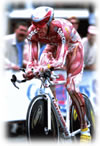By Richard Cimadoro, D.C.
It goes without saying that if your wheel is out of alignment, you won’t get far. But if you’re having to call a friend to pick you up twenty minutes into your 50 mile ride because your back’s killing you, maybe you need to keep reading. As a chiropractor and competitive cyclist, I share the analogous theory that being properly adjusted applies not only to your spine, but to your bicycle as well. To experience a ‘oneness’ between man and machine, proper fit is essential.
 Like attracts like. Do what you love and all else follows. It happens that I’ve had an affair with bicycles my whole life. Therefore, it’s no surprise that many of my patients are also cyclists. It began innocent enough, one cyclist would complain about knee pain, another of neck pain. Using the Dick Tracy method of asking the right questions, I have been able to offer effective advice to my cycling patients and keep them on the road.
Like attracts like. Do what you love and all else follows. It happens that I’ve had an affair with bicycles my whole life. Therefore, it’s no surprise that many of my patients are also cyclists. It began innocent enough, one cyclist would complain about knee pain, another of neck pain. Using the Dick Tracy method of asking the right questions, I have been able to offer effective advice to my cycling patients and keep them on the road.
When considering the needs of a serious cyclist, be on the lookout for obvious bio mechanical flaws. Some essential topics for a proper fit include: correct frame size, seat height, fore-aft of the saddle, and reach to the bars. Many of your patient’s neck, back and knee pains, as well as hand and saddle numbness can be resolved by looking at their setup.
1. Determining Correct Seat Height: There are many formulas for determining a proper seat height. I have found that knee flexion measured with a goniometer is most practical and reliable. Begin by having the patient pedal comfortably on a stationary trainer seated comfortably in the center of the saddle. Stop at the bottom of the pedal stroke and align the crank along the length of the seat tube. This is the lowest point. Measure the knee angle. A proper knee angle will be between 28-30 degrees.
2. Determining Correct Fore/Aft Saddle: After correct seat height, this is the most critical setting. This is important because it establishes balance on the bike and how connected they’ll feel to power output. If they are on a stationary trainer, make sure the front of the bike is level. Sitting in the heart of the saddle, place the cranks in a horizontal position (3 and 9 o’clock). Take a plumb line and drop it from the tibial. The plumb line should fall through the axle of the pedal. If it doesn’t fall correctly, move the saddle for/aft until the plumb line is centered where it needs to be. Using this as your reference point, you can now set the saddle position. Most competitive road cyclists prefer to leave their saddle in this neutral place and change their position by “sliding” along the saddle while riding-moving forward towards the nose for power and back for long climbs.
Note: Recheck your saddle height after adjusting your fore/aft because it can change.
3. Determining Correct Stem And Top Tube: Having the correct reach on your bicycle will be among the biggest factors in comfort, handling, balance and performance. As a starting point, the upper body should be 90 degrees to the upper arms when the hands are on the brake hoods. (Consider what kind of back they have, flat or rounded. Also whether they roll their hips forward on the seat (a good thing for racers, albeit sometimes uncomfortable) when determining your reach.
Another critical area to consider with a dedicated cyclist is flexibility. The most common complaints include: hamstrings, glutes, and hip-flexor tightness. Back pain in cycling, especially after climbing or hard efforts, can be addressed by proper stretching.
And finally, my favorite cycling story: The cyclist who came in with neck and back soreness, and after a few adjustments reported not needing his asthma inhaler anymore. Next week, I’ll look at his bike.
– – – – – – – – – –
Dr. Richard Cimadoro is a chiropractor in Thousand Oaks, California, a suburb of Los Angeles. He has been a competitive road cyclist for 16 years. For more information on bike fit, questions and/or comments, visit his website at: www.bodyfix.net.
planetc1.com-news @ 2:00 pm | Article ID: 1020459650




Comments are closed for this article!